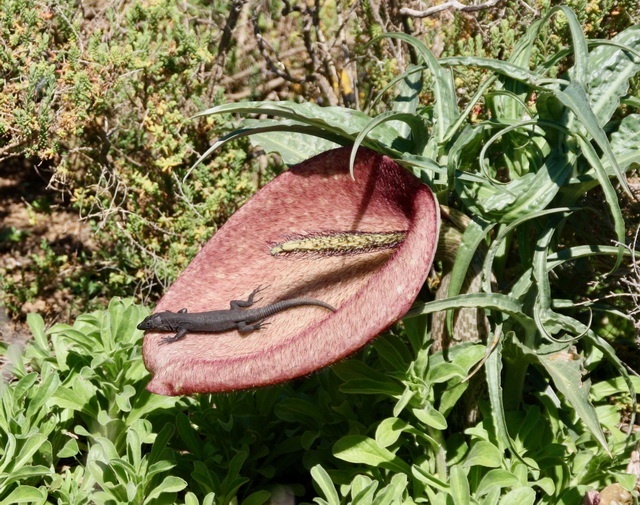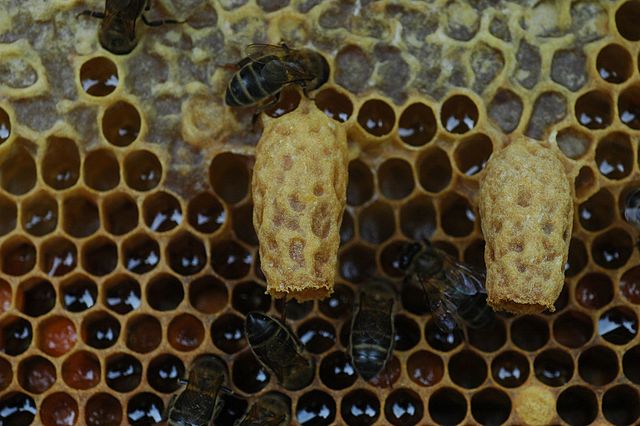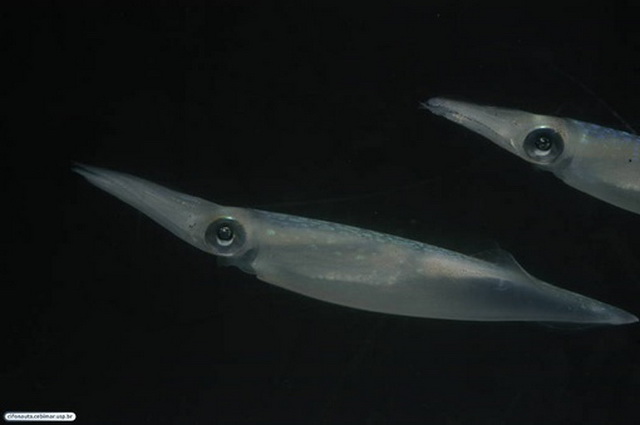Complex relationships between arum, blowflies and lizard
With its smell of rotting carrion, the dead-horse arum Helicodiceros muscivorus is irresistible to blowflies and a lizard. The blowflies will be abused, the lizard benefits. Ana Pérez-Cembranos and colleagues unraveled these complex relationships.
On islands in the Mediterranean Sea, a plant occurs with a very bad smell, the dead-horse arum, Helicodiceros muscivorus. Its odour contains chemical components that are also emitted by a decomposing dead animal. It irresistible to a female blowfly searching for carcasses to lay her eggs on to make sure that the carnivorous larvae will have food. The dead-horse arum takes advantage of that behaviour.
The plants release their odour on the first day of blooming. Blowflies that perceive the smell cannot ignore it. Upon approaching the source, they find a pink or red curved bract, the spathe, with the hairy end of the spadix (inflorescence), which produces the smell. When they land, the spadix turns out to be warm. To blowflies, the imitation is perfect: this is rotting carrion. Guided by the heat, they crawl into the tube that is formed by the base of the spathe around the lower part of the spadix, which bears female and male florets.
Trapped
Once inside, the blowflies don’t find what they need, which is decaying meat. But if they want to leave, they cannot. Spikes on the spadix keep the door closed. The blowflies are trapped.
Unintentionally, they provide a service to the arum during their imprisonment in the floral chamber. The female flowers at the bottom of the spadix are blooming this first day, and blowflies that had been misled by the arum before, now deliver the pollen that they picked up on that occasion. The plant has its female flowers pollinated.
The next day, the female flowers have faded and the male flowers are mature. The stench and the heat disappear, the spikes wilt and the blowflies escape, and while passing the male flowers, they are loaded with pollen. And here is the second benefit to the plant: the blowflies take the pollen with them to female flowers elsewhere – if at least they find another foul smelling arum on their way and are again misled into visiting it.
So, the blowflies are coerced to pollinate the dead-horse arum without receiving any reward such as nectar. On the contrary: they lose time that they should have spent on searching for genuine carcasses.
Basking
Now Ana Pérez-Cembranos and colleagues show that the Balearic lizard Podarcis lilfordi is also misled by the arum’s odour. The animal is omnivorous and sometimes forages on carcasses, which are also attractive as a heat source; lizards are cold-blooded and when the weather is cool, they may use a rotting carcass as a perching site for basking. In addition, they capture the blowflies that arrive at the cadaver in search for a site for oviposition.
The lizards respond to the smell of the dead-horse arum as they do to the smell of a carcass and will approach the source. If that turns out to be a dead-hors arum instead of a dead animal body, they will not find a meat meal, but they do find a basking place and blowflies, which they take from the spathe or grab from the tube. The lizards thus take away a number of pollinators, but, according to the researchers, enough are left to ensure pollination.
Fruits
So, the lizard isn’t an enemy of the arum. And after the flowering period, when fruits are ripe, a mutualism even develops between both. The lizards consume the fruits and disperse the seeds in their faeces; passage through the lizard’s intestine increases the probability of germination. On Aire Island, a the small island off the southeastern coast of Menorca, where the research was done, the dead-horse arum is a newcomer. It is estimated to have grown there for only about fifty years. In that period, it spread rapidly over the island and nowadays it locally occurs in great densities. That is because of the lizard, which has learned to eat the fruits and now is the main disperser of the seeds, the researchers think.
Willy van Strien
Photo: Balearic lizard on the spathe of the dead-horse arum © Ana Pérez-Cembranos
Sources:
Pérez-Cembranos, A., V. Pérez-Mellado & W.E. Cooper, 2018. Balearic lizards use chemical cues from a complex deceptive mimicry to capture attracted pollinators. Ethology 124: 260-268. Doi: 10.1111/eth.12728
Angioy, A-M., M. C. Stensmyr, I. Urru, M. Puliafito, I. Collu & B. S. Hansson, 2004. Function of the heater: the dead horse arum revisited. Proceedings of the Royal Society London B 271: S13-S15. Doi: 10.1098/rsbl.2003.0111
Stensmyr, M.C., I. Urru, I. Collu. M. Celander. B.S. Hansson & A-M. Angioy, 2002. Rotting smell of dead-horse arum florets. Nature 420: 625-626. Doi: 10.1038/420625a



